What is a Business Model Canvas? (Quick Guide and Examples)
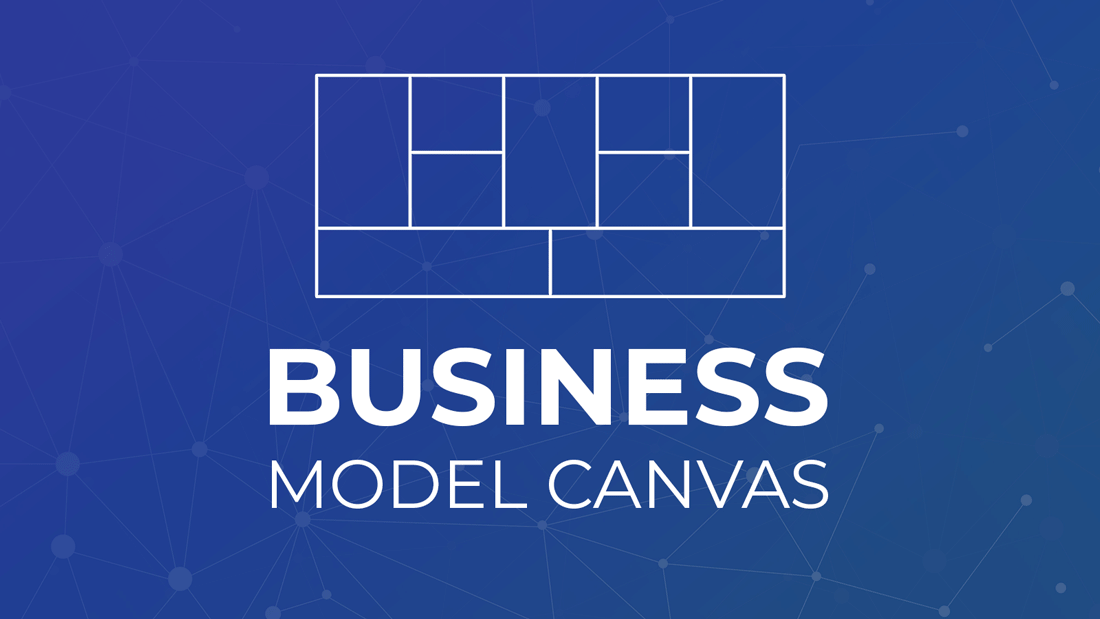
Based on the work of Alexander Osterwalder, a Business Model Canvas, or BMC for short, is a diagram used to visualize a business model; it allows structured organization and a quick method of evaluation and reflection on the effectiveness of a Business Models. The use and study of Business Model Canvas Examples allows to understand it in a complete way and apply it to different types of organizations.
Mục Lục
The Role of the Business Model Canvas
Whether it be in small business entrepreneurship or large corporate product launches, the business model sits at the center. The one thing that stands at the very heart of daily operations of an organization, a model dictates where the opportunity lies and how the company effectively acts on it at each step in the process.
The very best professionals will have all of this knowledge and action driving their decisions. However, the original business model one may follow may not always be applicable to the obstacles that an organization faces, thus it’s incredibly useful to fully display organizational structure and operations.
The Basics of the Business Model Canvas
Whether one is creating an all-new business model, comparing a pre-existing model, or adjusting a model to improve value, the BMC excels in keeping anyone invested in the business on track without wasting time and focus. By displaying only, the most critical pieces in business operations or a product, this tool is both a time saver and a method to sharpen your awareness of expectations vs. reality.
There are nine sections in a BMC, each containing a specified topic of information that composes the core of any business model.
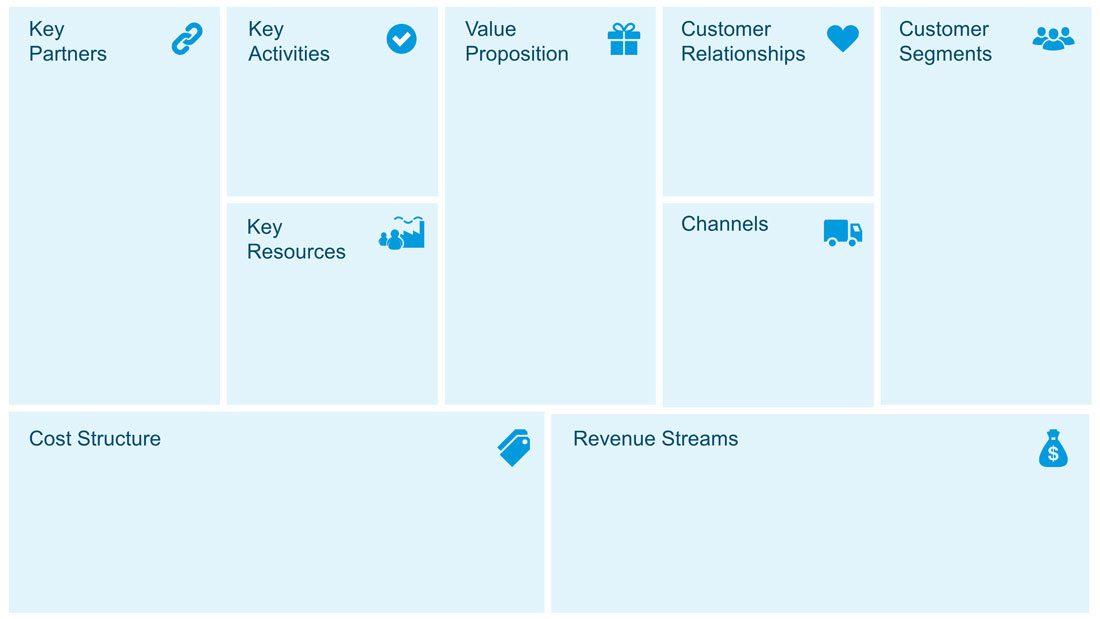
1. Customer Segments
This section contains the information related to the core target audience that you are selling towards. Simple and traditional segmentation analysis must be done to identify the top segments of the model. Start simple with questions like Which are the demographics of the major customer groups being targeted? Why are they going to be interested in the product or service? In essence, how well does the model comprehend who is being sold to? It is crucial that you identify clearly the segments as when facing reality, you will need to focus only in a few (1 or 2) to really test your model without a full operation in place.
2. Value Propositions
Create a list of the unique business value propositions you will offer. Why is the idea or company valuable? What makes it stand above competitors? If there aren’t any direct competitors, what gaps are being filled in given markets?
This section could be extremely lengthy, depending on the business model, but should only contain the most central concepts at the heart of the model that attract customers or generate revenues. This section will contain the aspects of the business that relieves a customer pains. If you’re struggling to identify what is most important, consider using a Value Proposition Canvas, another easy-to-visualize tool that helps establish your target audience with your strengths. Focus on solving a real pain for the segments identified.
3. Customer Relationships
The information of this section should refer to how to connect segments and the value proposition? During the analysis, you should be asking questions like How are customers convinced that your product or organization has the advertised special qualities? What methods are used to interact with them? How does an audience engage with each strategy in the product lifecycle? Additionally, how is customer engagement tracked?
4. Channels
Once the customer is convinced of the goods or services, how would you deliver it? This should include every step of the process it takes to make the financial transaction and value delivery possible. Is there a separate supplier? Who distributes the product? How is it displayed? Think about what the model requires from start to finish in order to make a sale.
5. Revenue Streams
If the customer connects with the product or service, and they want to proceed with doing business, then how does the actual exchange of money happen? How is the cash flow tracked? Are there any middlemen between the sale and the income to the business?
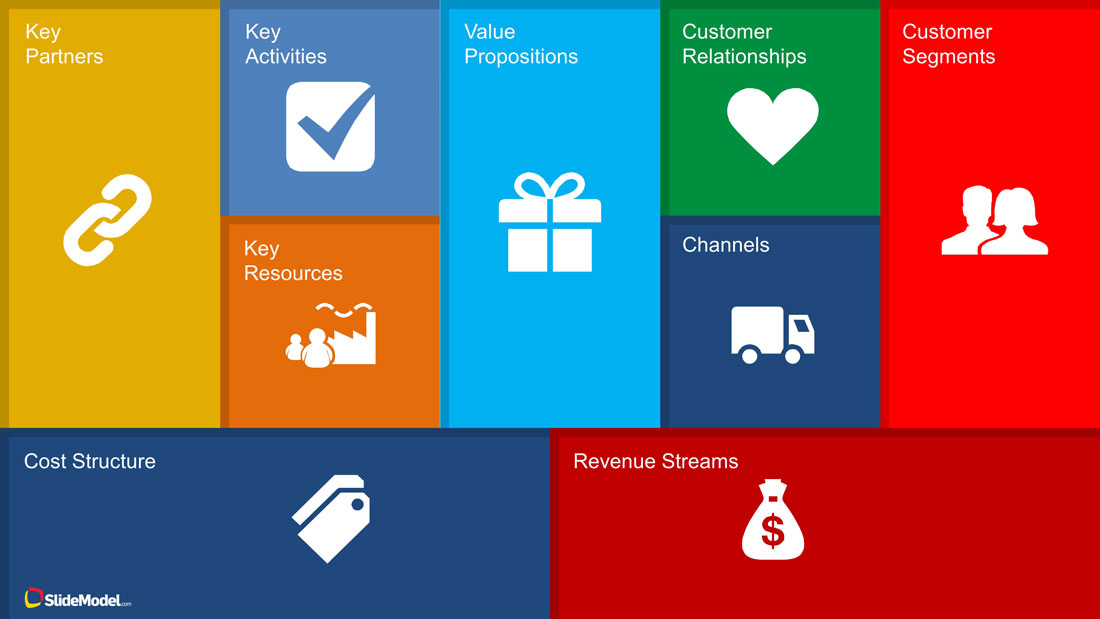
Source: Editable Business Model Canvas PowerPoint Template
6. Key Activities
This section should include specific activities that the organization will do to create value. Unlike the Value Propositions, it’s not just about a new product or business practice, but rather the day-to-day operations that each team will take.
7. Key Resources
Similar to Key Activities but focusing on assets that are used. Is there a special supplier? Is there access to any materials or a local storefront that puts you in an advantageous position? Do you have a special intellectual property or patent that introduces a new knowledge into the niche?
8. Key Partnerships
For areas that may be lacking, or areas that are too costly for the business to manage by itself, what can be outsourced to partners to focus on? Which areas would it be more cost efficient to hire from supporting businesses? Specifically, identify model strengths, maximize time and money on them, and move identified weaknesses to connected partners that can address them better or solve them altogether.
9. Cost Structure
Finally, what are the major expenses in the model? Are they a flat fee, or are they a variable cost? This may factor into previous sections, like key activities, resources, and partnerships.
Additionally, how does this relate to the Revenue Streams? How will the predicted costs vs. the actual be monitored? Most importantly, what will be done if costs outweigh the incoming funds?
Creating a Business Model Canvas involves analyzing each of these sections individually and as a whole, and connecting the dots between them.
The Power of a BMC in Entrepreneurship: Visualize the Business Model
Introducing a new business or product to the world is no small undertaking, especially when you consider how much competition and other new ideas are thrown into the world on a regular basis.
This also means keeping the model current and responsive. A business model, after all, is only a well-educated guess on how to generate success from a demand. If reality does not match up to the prediction, then even the very best business models are useless. A BMC is your abstract representation of how a business delivers value to customers to help them solve problems.
Steven Blank’s book to entrepreneurs and business leaders, ‘Four Steps to the Epiphany’, demonstrates the difference of those who watch and listen to their model in action, and those who convince themselves that their business model is flawless, and the world will adjust to follow it instead. The fact is, you may have the most amazing ideas in the world, but it won’t matter if you aren’t paying attention to unforeseen challenges that arise in between conception and actualization of a successful model.
The BMC is an excellent tool to get away from the guesswork, and out into the metaphorical streets. It allows an individual or team to compare expectations with reality, to double check targets and see if those targets are still manageable, and it gives an opportunity to make adjustments to a business model before it’s too late.
This practice is called, ‘Get out of the building’, an important part of the Lean Startup Methodology. It means to develop a BMC and test it against reality. For this to work, you need to create an MVP (Minimum Viable Product) that materializes your Value proposition and test it against real-life customers. Testing means that they should really purchase the MVP and that they complete the different sections of the BMC for true validation. This process is really iterative, and it helps entrepreneurs and business executives to make the adjustments necessary to really market a value proposition, reducing the risk of mounting a full-scale operation.
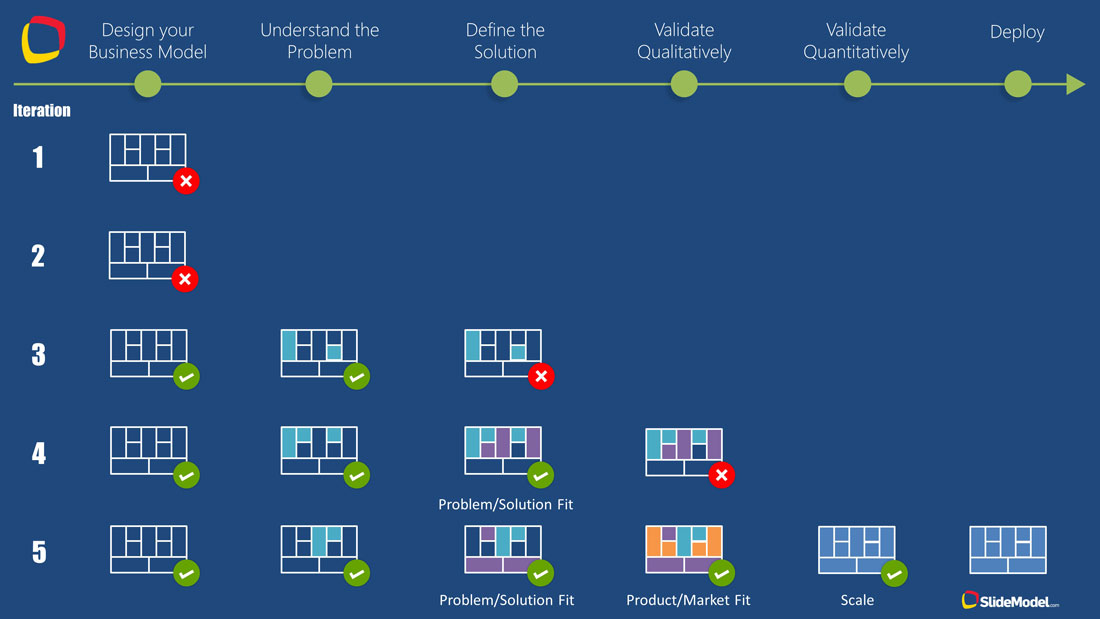 Business Model Canvas through different iterations
Business Model Canvas through different iterations
Business Model Canvas Examples
By using Business Model Canvas Examples, we can evaluate business models and identify just what changes need to be made to the model in order to ensure growth and success. In addition, analyzing Business Model Canvas examples and being able to study success stories is beneficial to be able to apply it in different industries.
MoviePass
Let’s take a look at the BMC Example of the MoviePass company, which launched with the idea to sell a monthly service to the general public for daily movie tickets at major theater chains for a flat monthly membership fee. The company reasoned that they could benefit two groups, the average moviegoer would be able to see more movies and movie theaters themselves would see better attendance.
In theory, it sounds like a reasonable concept, but in reality, MoviePass had not developed a functional business model which resulted in a poor performance against new technologies. There was no constant evaluation to keep track of their cash flow, and how by failing to keep the company growing fast enough, it couldn’t support the necessary costs. Perhaps if leadership had followed a BMC these issues may have been recognized earlier.
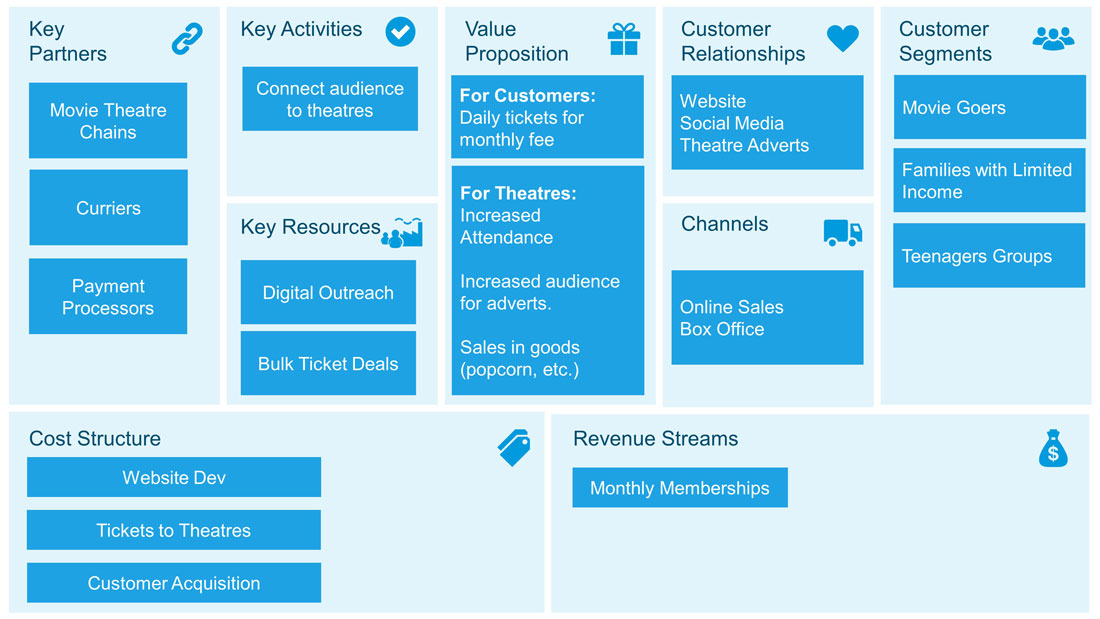 Business Model Canvas Example – MoviePass
Business Model Canvas Example – MoviePass
By using the BMC, MoviePass could have visualized earlier that the business model was in need of a pivot, a change to a section of the model in order to address an issue. In MoviePass case, areas like cash flow and customer acquisition had some gaps that required a solution. Had the company been more aware of their business model, they might have seen a need for a Minimum Viable Product (MVP) where they could test the results of their ideas with a few early adopters.
An MVP is the bare bones of a product or service that can provide invaluable information about how a small group of customers reacts. By having a testing period of limited engagement, a business can limit cost while drastically improving knowledge on how to proceed. Had MoviePass used this, they might’ve been able to observe early on that some customers used their service to the max, purchasing a movie ticket per day, far outweighing the profit of their service from the cost of providing it.
The pivot would adjust to their business model, and a new MVP could be created to test the new approach. This new iteration of the business may have changed the original direction of the company. Through each pivot and each new iteration of the model, MoviePass BMC would adjust accordingly, allowing an easy method in which to keep track of the major changes without getting overwhelmed in all the details that lay underneath each educated decision.
There are, however, examples of well-crafted business models that can be observed on a BMC. Let’s take a company that has spread its business model all over the world and has undoubtedly enacted countless pivots and iterations of the business model in order to evolve, adapt, and thrive over the years: McDonald’s.
McDonald’s
When thinking about the massive scope of McDonald’s, it’s both interesting and telling of how the BMC can still capture the essence of their business model. McDonald’s is a global corporate cash cow requiring a rock solid model, but that doesn’t mean it’s the same one since the conception of the company.
With the many decades in operation, you can be sure that a McDonald’s BMC would not look the same at the beginning as it does today. What originally started as a single burger joint on a street corner, now faces the challenges of global food service. Each time a new challenge or opportunity presented itself, the McDonald’s business model was forced to pivot by observing the environment, developing an appropriate plan of action, and monitoring the progress accordingly.
Over the years the world has grown to experience many iterations of the McDonald’s brand, whether it be an icon of American cuisine or an example of adaptation to dietary health. Flexible and ambitious, McDonald’s always made sure the business model matched desired outcomes.
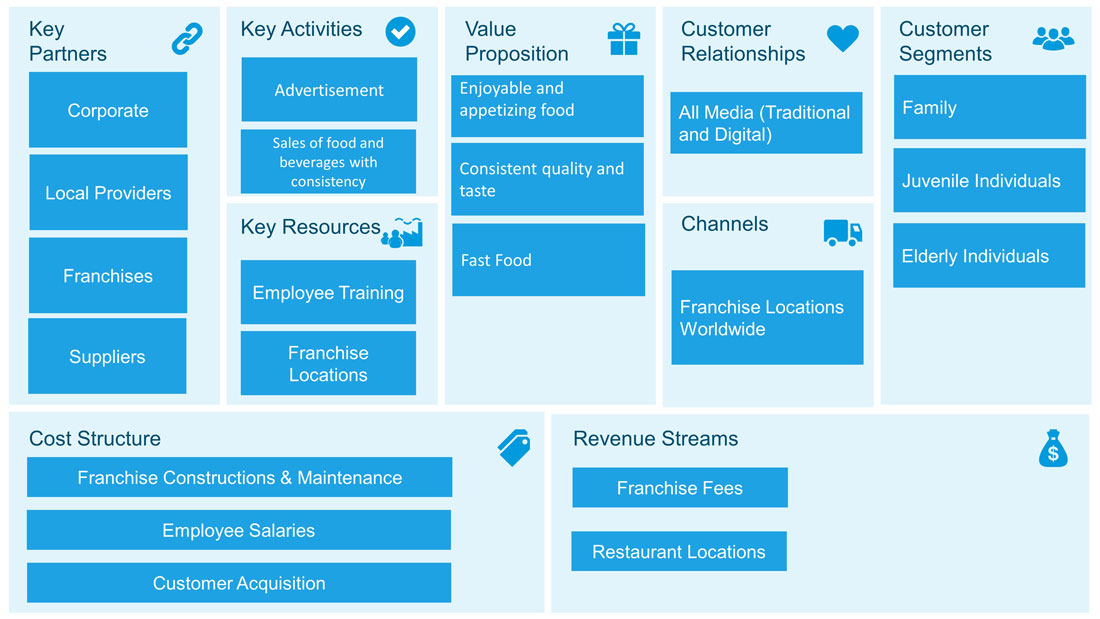 Business Model Canvas Example – McDonald’s
Business Model Canvas Example – McDonald’s
Uber
Uber is a ride hailing service that has caused massive disruption for conventional taxi services. By using digital technology and a specific standard for cars and drivers offered to customers, many taxi services and individual taxi drivers have found it hard to compete with Uber. In contrast to developed countries, taxi drivers in developing countries have been unable to meet the minimum vehicle standards to qualify as Uber drivers, competing them virtually out of the market. On the contrary, it has also attracted a new segment of people looking to use Uber as a part time job to earn extra money.
By looking at Uber using BMC Example we can see that its key partners include customers, drivers, payment processors, mapping data providers, and local authorities in the country it operates. Its key activities include developing its digital platform and algorithms, driver onboarding, marketing to balance demand and supply, and supporting customers using the service. The key resources of Uber are its digital platform, pricing and routing algorithms. Uber relies on a peer-to-peer (P2P) circular economy. Where customers and drivers continue to contribute to the Uber revenue in almost a loop. And since Uber is easier to use compared to conventional taxi services, both customers and drivers tend to often use it as a routine. For example, many drivers have completely switched to Uber from conventional taxi services and new drivers entering the market cannot imagine providing services without the model Uber provides. Similarly, customers can get used to the service in a way that the Uber service itself becomes a part of their daily routine.
The value proposition of Uber is provision of an on-demand taxi service for customers, whenever and wherever they need it. Uber fills the gap for the availability of an instant taxi service, without the need to necessarily ensure pre-booking or find a taxi manually. This offers user convenience, with various value benefits for both the customer and drivers, including the option to avail a cash free taxi service by customers, earning opportunities for drivers, and the supply of passengers and drivers through its ever-increasing base of users.
Uber reaches its customers and even attracts new drivers through its marketing and makes it easier for people to use its services through its app. Making it easy for the customers and drivers to communicate. Uber provides the utility of not just an on-demand service but also uses its algorithms to match supply and demand, find the shortest routes for customers and to allocate the closest driver. However, since Uber is primarily connecting customers and drivers, it also shifts much of its costs to the former, since it does not require owning and maintaining a large fleet of cars. It can also adjust its revenue based on the market its operating in, adjust price to match not only demand and supply but the purchasing power and market rates of the country or area it operates in.
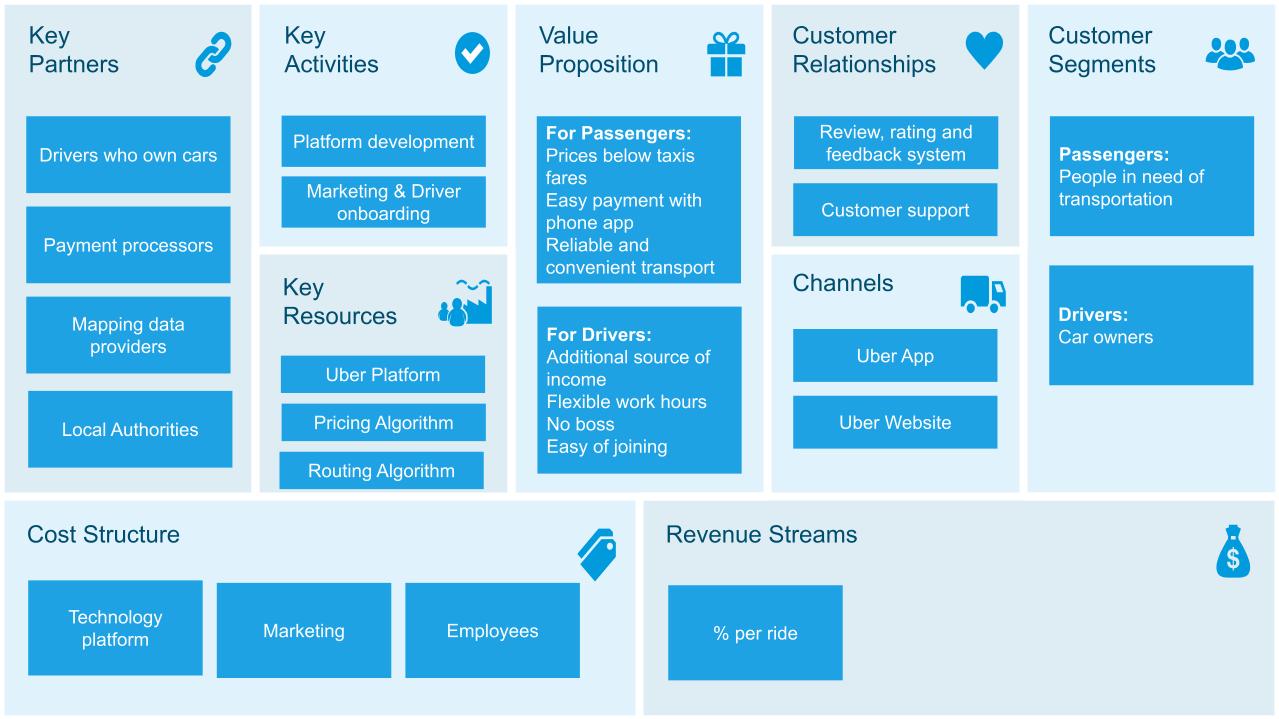 Business Model Canvas Example – Uber
Business Model Canvas Example – Uber
Amazon
When Amazon started in 1994, terms like e-commerce or online shopping were virtually unheard of. In fact, Amazon can be easily credited with being one of the first e-commerce platforms in the world. However, its customer led approach, with the convenience Amazon offered soon turned it into a famous retailer, which now has various other services attached to its name including an online video streaming platform called Amazon Prime, a cloud storage service (Amazon Drive), Kindle tablets, Fire TV, etc. However, to keep things simple, let’s look at Amazon’s BMC Example in the context of its retail store.
Amazon provides users with a range of services from its network of sellers. These sellers are rated by customers according to their experience and sellers that fail to adhere with Amazon’s standards are removed from the platform. For example, during the start of the COVID-19 pandemic, many people began hoarding hand sanitizers and selling them at inflated prices online. Amazon was quick to act to remove such vendors.
The approach that Amazon has is based on not just to connect buyers and sellers but to ‘continually raise the bar of the customer experience’. To ensure this, amazon often takes innovative steps that not only include improving its digital platform but also to ensure a steady supplier base. In 2019, Amazon announced $10,000 and three months worth of their gross salary to employees who quit their job and start a delivery service. Anticipating the need to expand its supplier base. Amazon has also been famous for offering competitive employee benefits and creating a corporate culture that encourages innovation and employee loyalty.
Through its colossal warehouses, customer centric approach and corporate culture that creates an atmosphere of employees to remain closely connected with the company, Amazon’s revenue stream simply does not rely on its customer experience, workforce or supplier base but how it’s able to create an environment where stakeholders, including customers and employees feel a sense of loyalty towards the company.
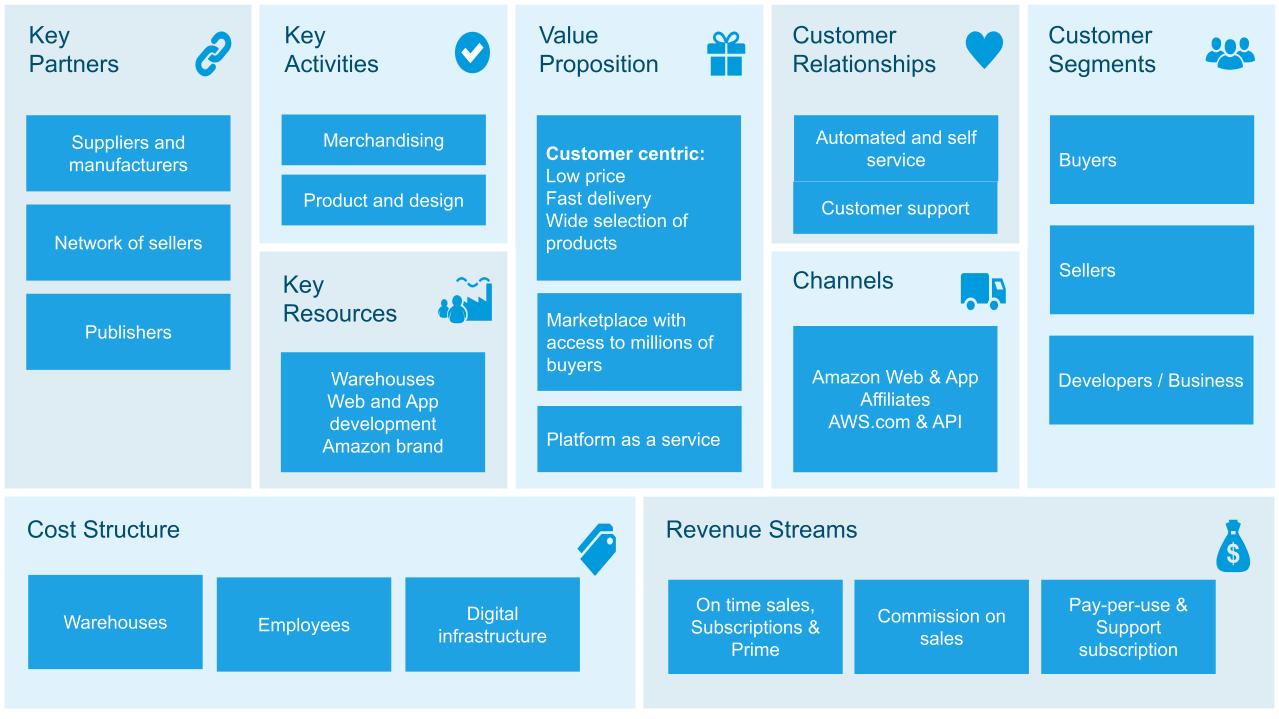 Business Model Canvas Example – Amazon
Business Model Canvas Example – Amazon
AirBnb
Over the years, AirBnb has been among companies that have leveraged their platform to transform conventional modes of doing business. Using its rating-based digital platform, AirBnb enables people looking to rent accommodation and hosts to be able to connect and become a part of its revenue stream with a few simple taps or clicks.
The platform has not only helped people who have conventionally been renting out their property but also enabled individuals with extra space to consider becoming hosts to earn extra money by renting out space for a short period of time. Similarly, the customers benefit from avoiding hefty rates of hotels and expensive accommodation options.
Like Uber, AirBnb has also been a disruptive force in the market it has operated. Using its digital infrastructure to connect travelers and hosts. While offering the value proposition of making money by utilizing underutilized space to hosts and offering low cost accommodation for people looking to save money. This model has enabled the company to surpass large hotel chains and make a major impact in the industry for rent and accommodation. In 2020 AirBnb was valued at $75 billion, surpassing giants like Hyatt Hotels valued at $2.07 billion and Marriott Hotels International valued at $10.57 billion.
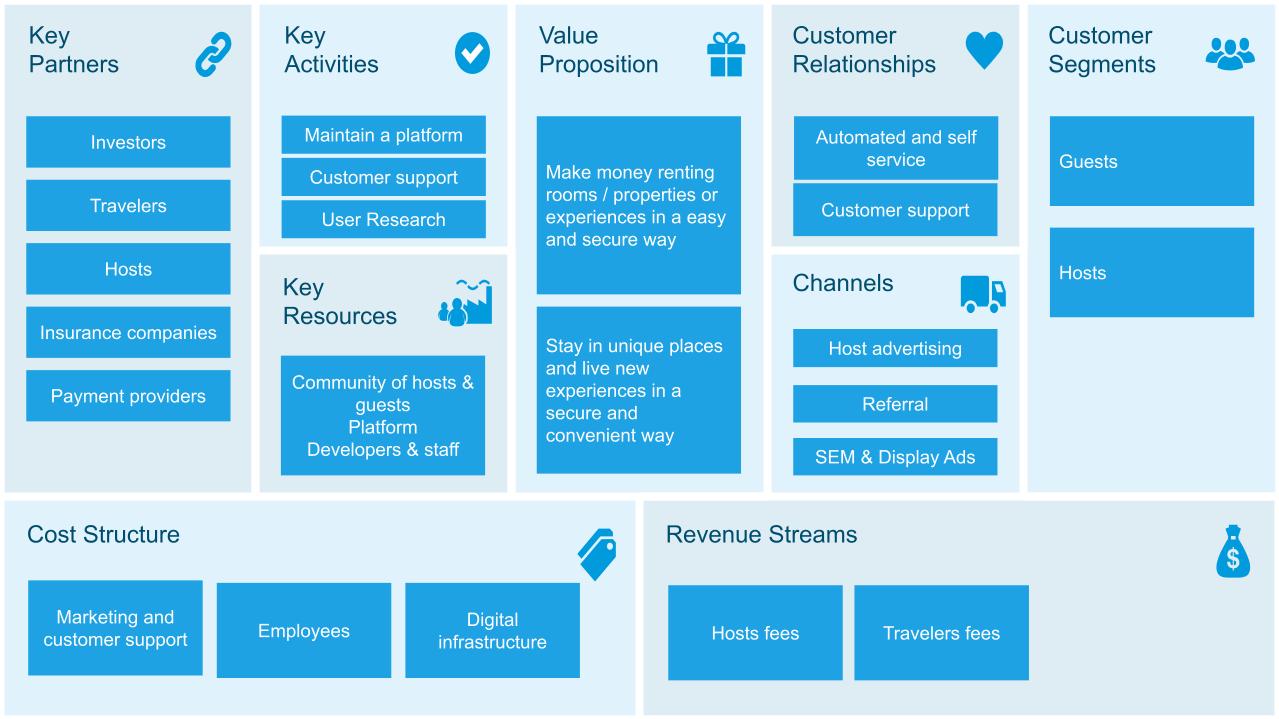 Business Model Canvas Example – AirBnb
Business Model Canvas Example – AirBnb
Netflix
From its launch in 1997 to 2006 in the United States, Netflix had a per-rental model per DVD. However, in 2007 it launched a subscription-based model that turned out to be more successful. Today, Netflix is available for streaming in over 190 countries, each with its own catalogue of Movies and TV shows.
According to Netflix’s Business Model Canvas Example, its value proposition is the provision of on-demand entertainment regardless of where you are. It’s subscription models provide access to one or more screens, with the utility to watch Netflix via mobile, tablet, laptop, gaming consoles, etc. Its packages include an economical package with a SD (480P) resolution limited to a single device to more exclusive packages offering Full HD (1080p) and Ultra HD (4K) and HDR (2160p) resolutions.
Needless to say, the market segment of Netflix is quite close to universal. Out maneuvering cable operators and conventional TV channels with exclusive on-demand content. While Netflix’s partners have included broadcasters and production companies, it has recently been focusing on original content. Through Netflix’s subscription-based model, there is very little need (if any) for customer interaction, unless a user is reporting a bug. The Netflix model focuses on self-service with a ‘all you can eat’ style subscription model, with algorithms constantly suggesting content to users to keep them engaged based on their viewing preferences.
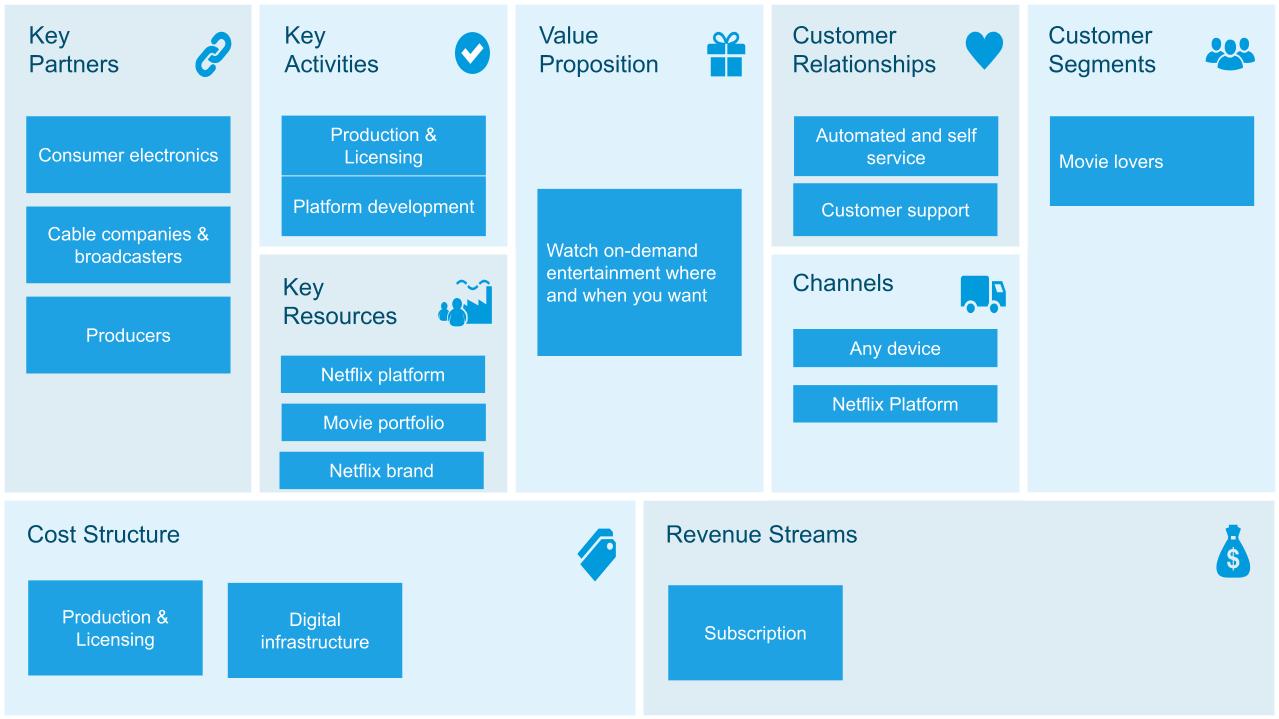 Business Model Canvas Example – Netflix
Business Model Canvas Example – Netflix
Ikea
Ikea’s value proposition is to provide affordable furniture that is sturdy, aesthetic, and functional enough to cater for customer needs. In doing so Ikea claims to create a better everyday life for people who use its products. The Business Model Canvas Example of Ikea includes its vendors, suppliers, franchisees, and logistics partners making it possible to reach out to customers globally.
Unlike companies like Amazon, e-commerce is only part of Ikea’s operations, as it has a robust physical presence in more than 50 countries. Over the years Ikea has undergone continuous product development with new furniture designs and a range of products being released on a consistent basis. This has helped the company to cater for the needs of different customer segments including families, businesses, and people who need something that is easy to use, assemble and disassemble.
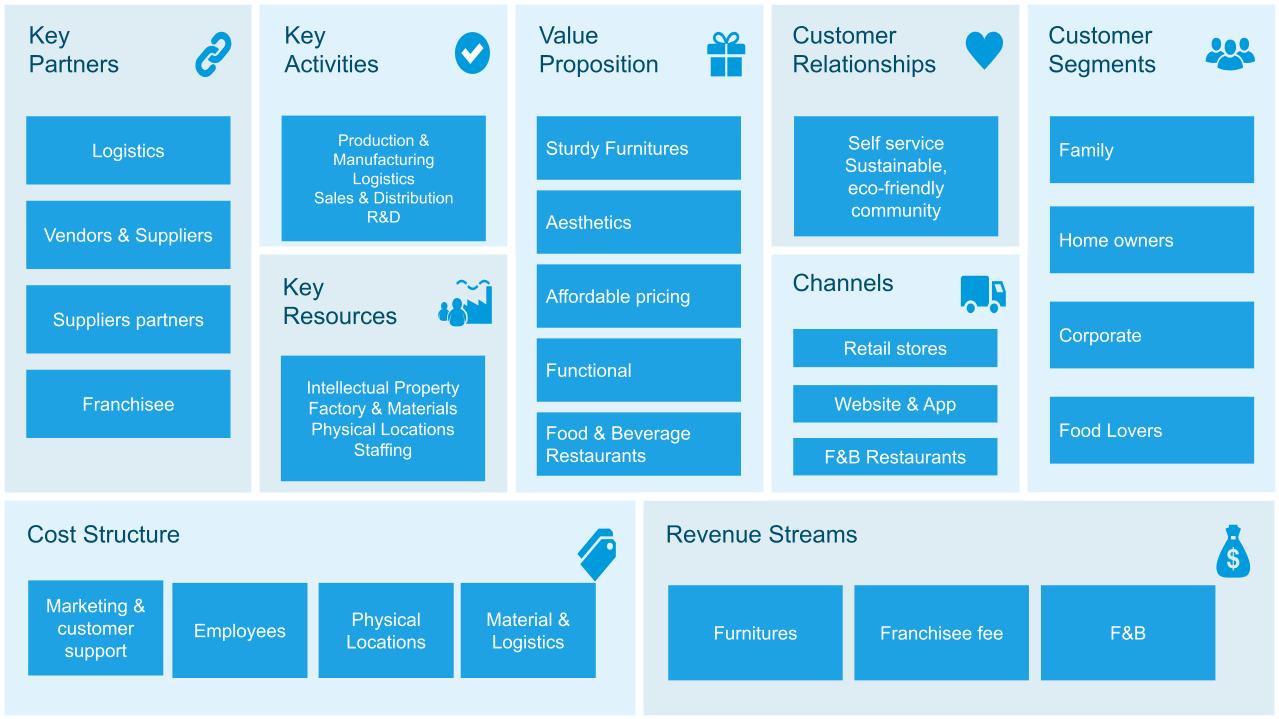 Business Model Canvas Example – Ikea
Business Model Canvas Example – Ikea
How to Utilize a Business Model Canvas for your Success
Whether it be a brand-new business endeavor or a product launch at a long-standing company, it’s critical that the business model is kept at the core of every decision. A Free Business Model Canvas Template is a tool to easily keep the model insight and offers an easy method to open the dialogue when that model may need to pivot.
The whole purpose of the BMC is to allow for a simple presentation of information, reducing complications in understanding just what is required in each new iteration of a business model. At a glance, anyone invested in the outcome of the model should be able to understand the who, what, when, where, and why’s of the model, or bring it to everyone’s attention if they don’t.
Most importantly, the BMC is a tool to help drive success. If there are issues in your business model that need to be addressed, a BMC makes it easier to visualize where the gaps are, and how they may be filled. Keep in mind that pivoting is crucial to the success and survival of a business model and that change, growth, and adaptation are not an abandonment of what matters, but a natural progression to find the best outcomes to the ultimate goal. As Eric Ries, author of Startup Lessons Learned, puts it: ‘pivoting may lead [successful startups] far afield from their original vision, but if you look carefully, you’ll be able to detect common threads that link each iteration.’
Business Model Canvas PowerPoint Templates
If you want to create professional looking Business Model Presentations, take a look at the following Business Model Canvas templates, ready to edit and easy to use.
















![Toni Kroos là ai? [ sự thật về tiểu sử đầy đủ Toni Kroos ]](https://evbn.org/wp-content/uploads/New-Project-6635-1671934592.jpg)


